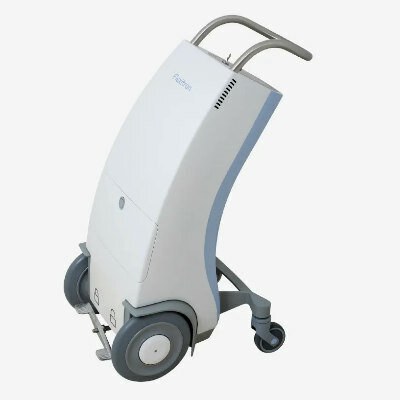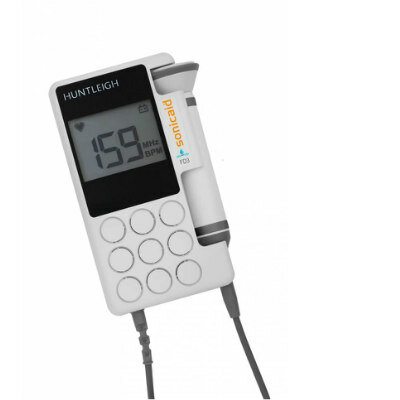Ergonomic Positioning System Reduces Radiologists Burden
|
By MedImaging International staff writers Posted on 27 May 2021 |

Image: Power Glide technology aids precise, ergonomic x-ray tube positioning (Photo courtesy of Shimadzu Medical Systems)
Novel power assist technology rapidly calculates the amount of assist-force required to position the radiographic system head precisely in position.
The Shimadzu Medical Systems (SMS; Kyoto, Japan) Power Glide system was developed for the company’s high-end radiographic systems. It is designed to instantaneously sense the amount of force applied by an operator during each movement, calculate the amount of assist-force required, and activate the positioning motors of the radiography system, thus providing effortless operating assistance for the radiographic environment. And as the force applied to the handle during operation varies among operators, the amount of power assist required differs as well.
The assist-force can be selected among three levels (low/mid/high) on the X-ray tube support touch panel. This ensures smooth operability by switching to a lower assist level for fine positioning, or to a higher assist level for performing large X-ray tube support movements quickly. Systems also include convenient functionality that makes fine positioning easier by automatically reducing the assist level whenever LED lamps are illuminated to point out the X-ray exposure field for fine positioning of the exposure area.
An extensive selection of various optional functionalities is also available, such as an auto-positioning functionality that can automatically move the X-ray tube support to registered positions; tomosynthesis functionality that can generate multi-slice images; or speed-stich functionality to generate long-view images for full spine or full leg examinations. Beyond power assist technology, Power Glide also involves innovations in sensing, shock reduction, balance, stability control, and torque control technologies that enable effortless manual operability of equipment weighing up to 300kg.
“In general radiography, the radiological technologist must maneuver an X-ray tube support assembly suspended from ceiling rails to position it to the target exposure area,” stated the company in the press release. “As general radiography is the first choice for diagnostic imaging involving many disorders found in the head, chest, abdomen, extremities and other areas, these daily procedures are used for an extremely large number of examinations. The extremely high responsiveness of Power Glide ensures the system can be comfortably and quickly positioned as intended in any situation.”
General radiography examinations require fine operability to position the X-ray exposure area to within a few millimeters by moving the X-ray tube assembly along ceiling rails. But due to the operator's risk of shoulder or lower back pain, there is a need to reduce operating loads by improving ergonomics, which also enables a smoother workflow and shortens the time that patients must maintain a particular body position during examinations.
The Shimadzu Medical Systems (SMS; Kyoto, Japan) Power Glide system was developed for the company’s high-end radiographic systems. It is designed to instantaneously sense the amount of force applied by an operator during each movement, calculate the amount of assist-force required, and activate the positioning motors of the radiography system, thus providing effortless operating assistance for the radiographic environment. And as the force applied to the handle during operation varies among operators, the amount of power assist required differs as well.
The assist-force can be selected among three levels (low/mid/high) on the X-ray tube support touch panel. This ensures smooth operability by switching to a lower assist level for fine positioning, or to a higher assist level for performing large X-ray tube support movements quickly. Systems also include convenient functionality that makes fine positioning easier by automatically reducing the assist level whenever LED lamps are illuminated to point out the X-ray exposure field for fine positioning of the exposure area.
An extensive selection of various optional functionalities is also available, such as an auto-positioning functionality that can automatically move the X-ray tube support to registered positions; tomosynthesis functionality that can generate multi-slice images; or speed-stich functionality to generate long-view images for full spine or full leg examinations. Beyond power assist technology, Power Glide also involves innovations in sensing, shock reduction, balance, stability control, and torque control technologies that enable effortless manual operability of equipment weighing up to 300kg.
“In general radiography, the radiological technologist must maneuver an X-ray tube support assembly suspended from ceiling rails to position it to the target exposure area,” stated the company in the press release. “As general radiography is the first choice for diagnostic imaging involving many disorders found in the head, chest, abdomen, extremities and other areas, these daily procedures are used for an extremely large number of examinations. The extremely high responsiveness of Power Glide ensures the system can be comfortably and quickly positioned as intended in any situation.”
General radiography examinations require fine operability to position the X-ray exposure area to within a few millimeters by moving the X-ray tube assembly along ceiling rails. But due to the operator's risk of shoulder or lower back pain, there is a need to reduce operating loads by improving ergonomics, which also enables a smoother workflow and shortens the time that patients must maintain a particular body position during examinations.
Latest Radiography News
- Novel Breast Imaging System Proves As Effective As Mammography
- AI Assistance Improves Breast-Cancer Screening by Reducing False Positives
- AI Could Boost Clinical Adoption of Chest DDR
- 3D Mammography Almost Halves Breast Cancer Incidence between Two Screening Tests
- AI Model Predicts 5-Year Breast Cancer Risk from Mammograms
- Deep Learning Framework Detects Fractures in X-Ray Images With 99% Accuracy
- Direct AI-Based Medical X-Ray Imaging System a Paradigm-Shift from Conventional DR and CT
- Chest X-Ray AI Solution Automatically Identifies, Categorizes and Highlights Suspicious Areas
- AI Diagnoses Wrist Fractures As Well As Radiologists
- Annual Mammography Beginning At 40 Cuts Breast Cancer Mortality By 42%
- 3D Human GPS Powered By Light Paves Way for Radiation-Free Minimally-Invasive Surgery
- Novel AI Technology to Revolutionize Cancer Detection in Dense Breasts
- AI Solution Provides Radiologists with 'Second Pair' Of Eyes to Detect Breast Cancers
- AI Helps General Radiologists Achieve Specialist-Level Performance in Interpreting Mammograms
- Novel Imaging Technique Could Transform Breast Cancer Detection
- Computer Program Combines AI and Heat-Imaging Technology for Early Breast Cancer Detection
Channels
MRI
view channel
PET/MRI Improves Diagnostic Accuracy for Prostate Cancer Patients
The Prostate Imaging Reporting and Data System (PI-RADS) is a five-point scale to assess potential prostate cancer in MR images. PI-RADS category 3 which offers an unclear suggestion of clinically significant... Read more
Next Generation MR-Guided Focused Ultrasound Ushers In Future of Incisionless Neurosurgery
Essential tremor, often called familial, idiopathic, or benign tremor, leads to uncontrollable shaking that significantly affects a person’s life. When traditional medications do not alleviate symptoms,... Read more
Two-Part MRI Scan Detects Prostate Cancer More Quickly without Compromising Diagnostic Quality
Prostate cancer ranks as the most prevalent cancer among men. Over the last decade, the introduction of MRI scans has significantly transformed the diagnosis process, marking the most substantial advancement... Read moreUltrasound
view channel
Deep Learning Advances Super-Resolution Ultrasound Imaging
Ultrasound localization microscopy (ULM) is an advanced imaging technique that offers high-resolution visualization of microvascular structures. It employs microbubbles, FDA-approved contrast agents, injected... Read more
Novel Ultrasound-Launched Targeted Nanoparticle Eliminates Biofilm and Bacterial Infection
Biofilms, formed by bacteria aggregating into dense communities for protection against harsh environmental conditions, are a significant contributor to various infectious diseases. Biofilms frequently... Read moreNuclear Medicine
view channel
New SPECT/CT Technique Could Change Imaging Practices and Increase Patient Access
The development of lead-212 (212Pb)-PSMA–based targeted alpha therapy (TAT) is garnering significant interest in treating patients with metastatic castration-resistant prostate cancer. The imaging of 212Pb,... Read moreNew Radiotheranostic System Detects and Treats Ovarian Cancer Noninvasively
Ovarian cancer is the most lethal gynecological cancer, with less than a 30% five-year survival rate for those diagnosed in late stages. Despite surgery and platinum-based chemotherapy being the standard... Read more
AI System Automatically and Reliably Detects Cardiac Amyloidosis Using Scintigraphy Imaging
Cardiac amyloidosis, a condition characterized by the buildup of abnormal protein deposits (amyloids) in the heart muscle, severely affects heart function and can lead to heart failure or death without... Read moreGeneral/Advanced Imaging
view channel
New AI Method Captures Uncertainty in Medical Images
In the field of biomedicine, segmentation is the process of annotating pixels from an important structure in medical images, such as organs or cells. Artificial Intelligence (AI) models are utilized to... Read more.jpg)
CT Coronary Angiography Reduces Need for Invasive Tests to Diagnose Coronary Artery Disease
Coronary artery disease (CAD), one of the leading causes of death worldwide, involves the narrowing of coronary arteries due to atherosclerosis, resulting in insufficient blood flow to the heart muscle.... Read more
Novel Blood Test Could Reduce Need for PET Imaging of Patients with Alzheimer’s
Alzheimer's disease (AD), a condition marked by cognitive decline and the presence of beta-amyloid (Aβ) plaques and neurofibrillary tangles in the brain, poses diagnostic challenges. Amyloid positron emission... Read more.jpg)
CT-Based Deep Learning Algorithm Accurately Differentiates Benign From Malignant Vertebral Fractures
The rise in the aging population is expected to result in a corresponding increase in the prevalence of vertebral fractures which can cause back pain or neurologic compromise, leading to impaired function... Read moreImaging IT
view channel
New Google Cloud Medical Imaging Suite Makes Imaging Healthcare Data More Accessible
Medical imaging is a critical tool used to diagnose patients, and there are billions of medical images scanned globally each year. Imaging data accounts for about 90% of all healthcare data1 and, until... Read more
Global AI in Medical Diagnostics Market to Be Driven by Demand for Image Recognition in Radiology
The global artificial intelligence (AI) in medical diagnostics market is expanding with early disease detection being one of its key applications and image recognition becoming a compelling consumer proposition... Read moreIndustry News
view channel
Bayer and Google Partner on New AI Product for Radiologists
Medical imaging data comprises around 90% of all healthcare data, and it is a highly complex and rich clinical data modality and serves as a vital tool for diagnosing patients. Each year, billions of medical... Read more



















